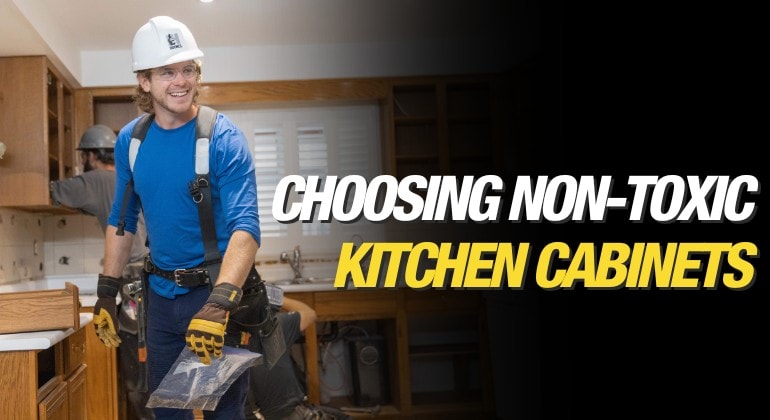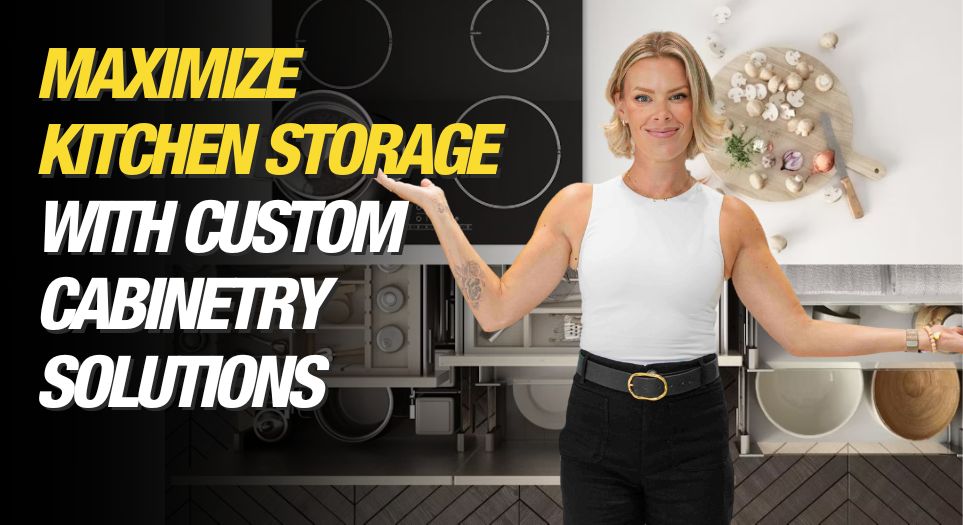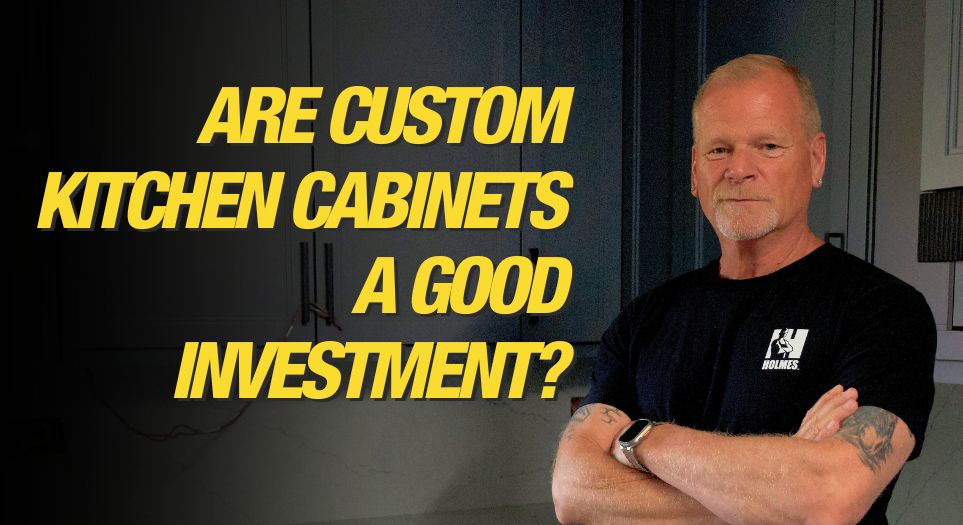Cleaning gutters is one of those chores most homeowners dread—and often put off—but it’s an essential part of protecting your home. Installing gutter guards can significantly cut down on...

7 Tips for Choosing Non-Toxic Kitchen Cabinets
By Mike Holmes Jr
Mike’s Advice / Healthy lifestyle
Monday, April 28th, 2025 @ 3:47pm
Choose Non-Toxic, Eco-Friendly Kitchen Cabinets for a Healthier Home
Kitchen cabinets and doors are a key part of your kitchen design, and you want them to look good. However, do you think about where and what your kitchen cabinets are made of? How do you choose non-toxic, eco-friendly kitchen cabinets for a healthier home?
When sourcing products for our show, we always seek new and innovative solutions that promote a healthier home. This includes improving indoor air quality with air purifiers or energy recovery ventilators (ERV/HRV), using waterproof systems in all our bathroom renovations, and partnering with local suppliers and manufacturers for items like furniture and windows.
Some of you may also know that I am in the process of building a new home for my family. We love our property north of the city and we intend on staying here for a long time, so sourcing eco-friendly, sustainable products is important to me and my family.
Choosing non-toxic, eco-friendly kitchen cabinets is a great step toward creating a healthier home.
Why Your Kitchen Cabinets Matter
Whether you have space for many cabinets or need to optimize for a small space, you want your new kitchen to be made of high-quality products that look good, maximize storage and functionality, and be in a layout that works best for you.
More homeowners are becoming conscious of how cabinets and doors are made, and they are asking for more high-quality eco-friendly products. This means, in part, no off-gassing from paints, stains, or adhesives. Homeowners also want to use sustainable woods and materials.
When I heard about Milmonde, a custom cabinet manufacturer out of Quebec that aligns with my values, I wanted to learn more.
Renovations are time-consuming and costly, so you want them to last and look good. It can be overwhelming in today’s world of choices but take your time and research.
Based on what I learnt from my research, here’s a guide on what to consider when sourcing kitchen cabinet materials.
RELATED
1. Low-VOC or Zero-VOC Paints and Stains
Creating a healthy home is extremely important to me and my family so we try to find products and building materials that contain little or no toxic off-gassing.
VOCs are volatile organic compounds. These are chemicals found in paints, stains, varnishes and adhesives that can off-gas into the air.
VOCs, along with other allergens, affect your indoor air quality. This is not good for anyone, but especially people with allergies, respiratory issues, or young kids.
Kitchen cabinets often use paints, stains and adhesives that have high levels of VOCs. In my mind, this is not good for me or my young family. Instead, I’m looking for a manufacturer that produces kitchen cabinets using low or zero-VOCs in their finishes, stains and paints.
.
PRO TIP: Look for products certified by Greenguard or other environmental certifications that ensure low VOCs.
Milmonde has been a pioneer in converting to water-based products and drastically reducing VOCs. In fact, they were the first company in North America to switch to water-based paints over 10 years ago. Lower VOCs mean cleaner, safer air in your home.
BONUS: Cabinets That Help Clean Your Air
Here is something I haven’t seen before but I think is amazing! While it’s still in its research and development phase, Milmonde manufactures cabinets that not only have lower VOCs but can also help improve your indoor air quality.
I didn’t believe it myself at first but using a special formula, Milmonde cabinets naturally filter indoor toxic contaminants. With us spending so much time in our kitchen, it being the heart of the home, this makes a big difference. Better air quality = a healthier home.
RELATED
2. Choose Formaldehyde-Free Products
Formaldehyde-based adhesives are a major toxin found in wooden cabinets made from plywood or particleboard. Formaldehyde is a respiratory irritant and a potential carcinogen. That’s not something I want in my new home.
All the glue or adhesives used in the manufacturing of the Milmonde kitchen cabinets have no formaldehyde.
Using solid wood for the cabinets is ideal, it’s a natural product so there is usually no worry there. But I get that it also comes with a higher price tag.
There are lots of great alternatives and more budget-friendly options, but make sure to ask if the cabinets are made from formaldehyde-free plywood.
Some key certifications to check for include:
- NAF (No Added Formaldehyde)
- CARB Phase 2 Compliant.
3. Opt for Sustainable Wood and Materials
Unsustainable logging contributes to deforestation and habitat destruction. I learned so much while I was touring the forests with the Forest Stewardship Council (FSC) last fall, in northern Ontario.
The work FSC does is fantastic and ensures wood in Canada is sustainably harvested.
If you’re looking for environmentally friendly cabinets, check for wood products that are FSC (Forest Stewardship Council)-Certified Wood.
Also, reclaimed or recycled wood reduces the environmental impact. Bamboo is another excellent option as it’s fast-growing and durable.
4. Use Durable, Long-Lasting Materials
Like my dad, I believe in doing it right the first time, and I also believe in using products that will last for decades.
Choosing products that last a long time is eco-friendly, as it helps reduce waste. Durable, wooden cabinets that will last for decades are much more sustainable than cheap, low-quality alternatives.
Here are some things to look for:
- Solid wood or engineered wood that resists warping
- Bamboo or reclaimed wood for sustainability and durability
- FSC-certified wood is an eco-friendly choice from responsibly managed forests.
- Cabinets with strong warranties for added peace of mind
Pro Tip:
Milmonde has been a pioneer in converting to water-based products and drastically reducing VOCs. In fact, they were the first company in North America to switch to water-based paints over 10 years ago. Lower VOCs mean cleaner, safer air in your home.
5. Choose a Sustainable Manufacturer
Beyond materials, how a manufacturer operates matters. A truly sustainable company minimizes waste, reduces energy consumption, and offsets carbon emissions.
Look for manufacturers with certifications such as:
- LEED (Leadership in Energy and Environmental Design)
- Cradle to Cradle Certified for sustainable lifecycle practices
- B Corporation status for environmental and social responsibility
One of the best things about Milmonde is that they are committed to environmentally conscious practices and I love this.
Milmonde is a carbon-neutral company. Meaning any carbon footprint they create, they plant trees to offset their carbon footprint. By integrating sustainable manufacturing practices, Milmonde is pushing the boundaries of responsible innovation.
All the materials they use are recyclable, which I also love.
6. Avoid Plastics and PVC
The use of plastics and PVC is well integrated into our everyday lives. However, homeowners are and should consider using more natural materials. Put simply they are better for you and for the environment.
I prefer to use materials that avoid plastics and PVC (polyvinyl chloride). I suggest looking at cabinets made from natural wood, bamboo or stainless steel. Avoid vinyl-wrapped or laminate cabinets unless the laminate is eco-friendly.
Milmonde works with a wide range of price points and materials like laminate, polymer, thermoform, MDF and veneer. These wood alternatives use sustainable materials, such as biodegradable or recycled plastics and polymers, reducing the environmental footprint and minimizing the accumulation of plastic waste.
In addition, Milmonde can also match any colour with their extensive colour development program.
7. Verify Certifications and Labels
The world of kitchen cabinets is vast and the choices are endless. To help narrow down your search look for certifications to ensure that the products you are choosing meet eco-friendly and non-toxic standards.
Certifications to look for include:
- GREENGUARD Gold (low chemical emissions).
- FSC (Forest Stewardship Council) for sustainable sourced wood.
- Eco-Certified Composite for sustainable engineered wood.
- Cradle to Cradle Certified for sustainable lifecycle practices.
BONUS: Choose a Company that has a Solid Process
Kitchen renovations are a major investment, so they need to be properly managed so you can avoid costly mistakes.
I’m not saying that an experienced handyperson couldn’t take on the job, but I am saying it is risky as even a few centimeters can sometimes make all the difference when it’s time for installation.
This is where I would consult with the professionals, and hire a kitchen designer or interior designer or builder to get the best results.
Many things can go wrong during a kitchen renovation. It all comes down to the details. Measuring, lots of measuring and checking appliances and rechecking against the layout is needed for a hassle-free installation.
Also, think of the millwork that finishes off the areas around your cabinets. Everything needs to be precise. Milmonde’s team takes this seriously.
Their fool-proof process helps eliminate errors. They work with professional designers, builders and installers to help ensure the process is accurate from start to finish. This includes several design reviews to ensure your kitchen cabinets, doors and millwork are exactly to your specifications when they arrive.
The Milmonde Process
- Step One: After consultations, with the client, the designer or builder creates the design rendering based on the customer needs, and space requirements. Once reviewed and approved by the customer, the design is sent to the Milmonde quoting team.
- Step Two: The Milmonde quoting team is a second set of eyes to review the design, and requirements for the kitchen renovation. Once reviewed, they can flag any issues with functionality or regulations, and these issues can be rectified before any work has been started. This saves both time and money on costly mistakes.
- Step Three: The order is reviewed by the technical team, another set of eyes and quality control before the kitchen cabinets are ordered. Then the team purchases the raw material and cuts everything to the exact size using high-end machinery.
- Step Four: The cabinets are fabricated and packaged and shipped out to you.
Kitchen renovations are time-consuming and costly, so you want them to last long and look good too. In today’s world of choices, it can be overwhelming, but take your time, research your product options and decide what is important to you.
If you are looking for non-toxic, more eco-friendly kitchen cabinets and doors, these tips will help you find the perfect choice and take steps towards creating a healthier home for you and your family.
*Disclaimer: I only recommend products I would use myself and all opinions expressed here are our own. This post may contain affiliate links.
READ NEXT
How to Choose the Best Kitchen Cabinet Layout for Small & Large Spaces











